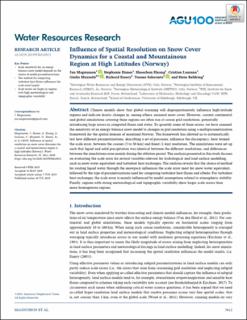| dc.contributor.author | Magnusson, Jan | |
| dc.contributor.author | Eisner, Stephanie | |
| dc.contributor.author | Huang, Shaochun | |
| dc.contributor.author | Lussana, Cristian | |
| dc.contributor.author | Mazzotti, Giulia | |
| dc.contributor.author | Essery, Richard | |
| dc.contributor.author | Saloranta, Tuomo | |
| dc.contributor.author | Beldring, Stein | |
| dc.date.accessioned | 2020-04-15T11:00:04Z | |
| dc.date.available | 2020-04-15T11:00:04Z | |
| dc.date.created | 2019-11-29T13:59:13Z | |
| dc.date.issued | 2019-06-07 | |
| dc.identifier.citation | Water Resources Research. 2019, 55 (7), 5612-5630. | en_US |
| dc.identifier.issn | 0043-1397 | |
| dc.identifier.uri | https://hdl.handle.net/11250/2651129 | |
| dc.description.abstract | Climate models show that global warming will disproportionately influence high‐latitude regions and indicate drastic changes in, among others, seasonal snow cover. However, current continental and global simulations covering these regions are often run at coarse grid resolutions, potentially introducing large errors in computed fluxes and states. To quantify some of these errors, we have assessed the sensitivity of an energy‐balance snow model to changes in grid resolution using a multiparametrization framework for the spatial domain of mainland Norway. The framework has allowed us to systematically test how different parametrizations, describing a set of processes, influence the discrepancy, here termed the scale error, between the coarser (5 to 50‐km) and finest (1‐km) resolution. The simulations were set up such that liquid and solid precipitation was identical between the different resolutions, and differences between the simulations arise mainly during the ablation period. The analysis presented in this study focuses on evaluating the scale error for several variables relevant for hydrological and land surface modelling, such as snow water equivalent and turbulent heat exchanges. The analysis reveals that the choice of method for routing liquid water through the snowpack influences the scale error most for snow water equivalent, followed by the type of parametrizations used for computing turbulent heat fluxes and albedo. For turbulent heat exchanges, the scale error is mainly influenced by model assumptions related to atmospheric stability. Finally, regions with strong meteorological and topographic variability show larger scale errors than more homogenous regions. | en_US |
| dc.language.iso | eng | en_US |
| dc.title | Influence of Spatial Resolution on Snow Cover Dynamics for a Coastal and Mountainous Region at High Latitudes (Norway) | en_US |
| dc.type | Peer reviewed | en_US |
| dc.type | Journal article | en_US |
| dc.description.version | publishedVersion | en_US |
| dc.rights.holder | ©2019. American Geophysical Union. | en_US |
| dc.subject.nsi | VDP::Landbruks- og Fiskerifag: 900 | en_US |
| dc.source.pagenumber | 5612-5630 | en_US |
| dc.source.volume | 55 | en_US |
| dc.source.journal | Water Resources Research | en_US |
| dc.source.issue | 7 | en_US |
| dc.identifier.doi | 10.1029/2019WR024925 | |
| dc.identifier.cristin | 1754637 | |
| dc.relation.project | Mediehøgskolen Gimlekollen: https://thredds.met.no/thredds/catalog.html | en_US |
| dc.relation.project | Norges forskningsråd: 243803 (I:CAN) | en_US |
| cristin.ispublished | true | |
| cristin.fulltext | original | |
| cristin.qualitycode | 1 | |
